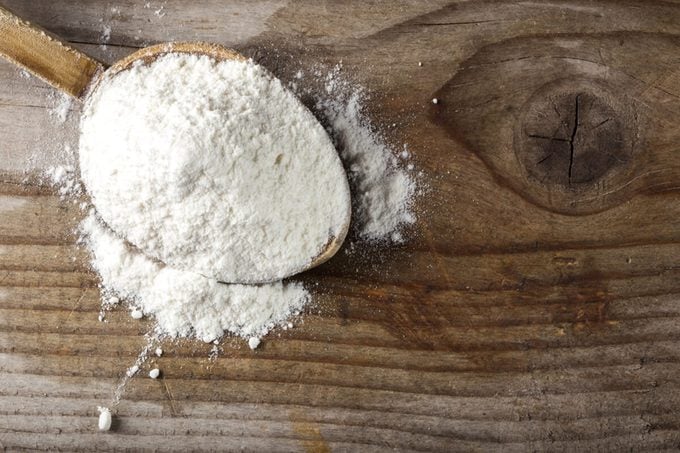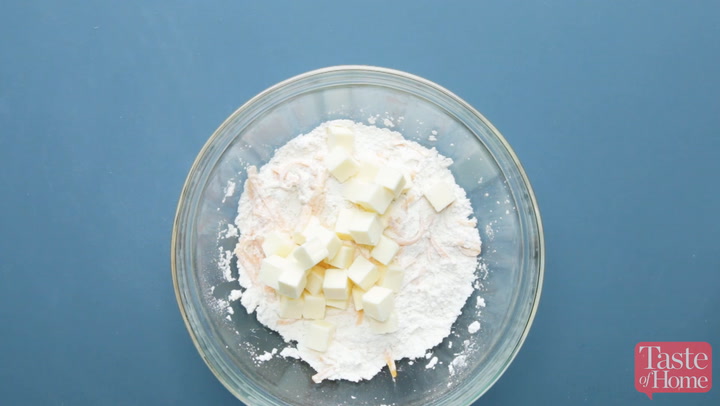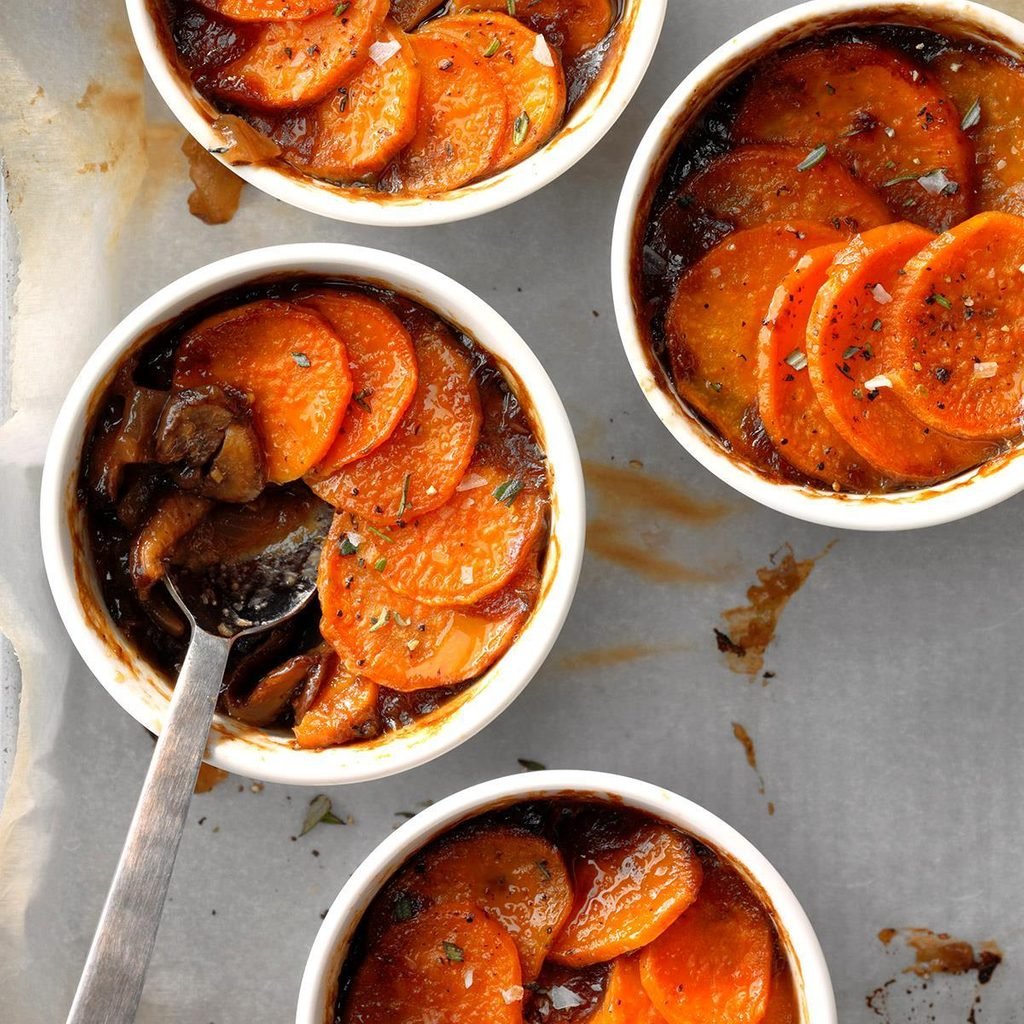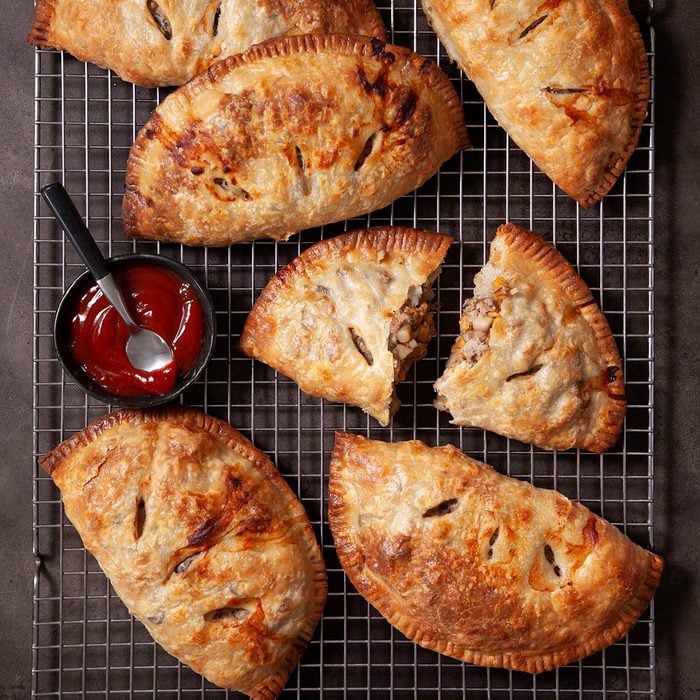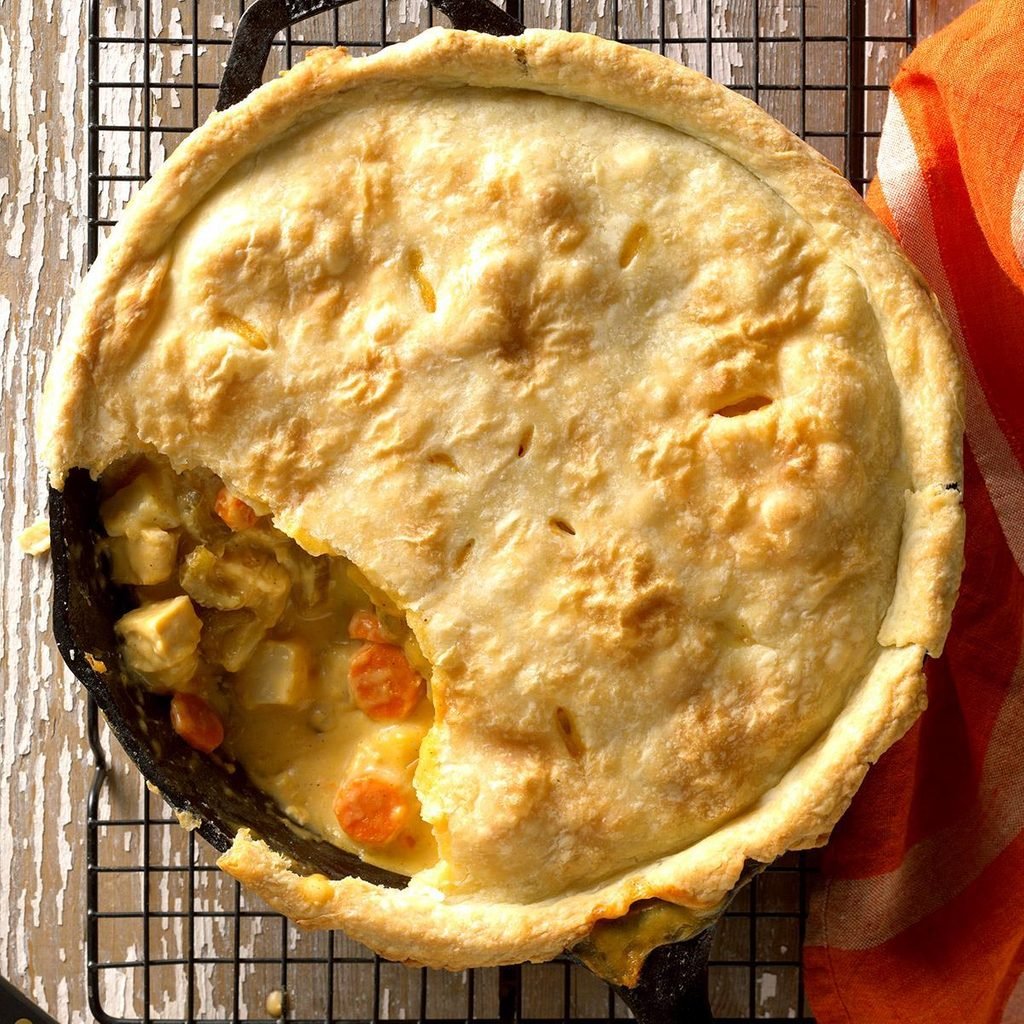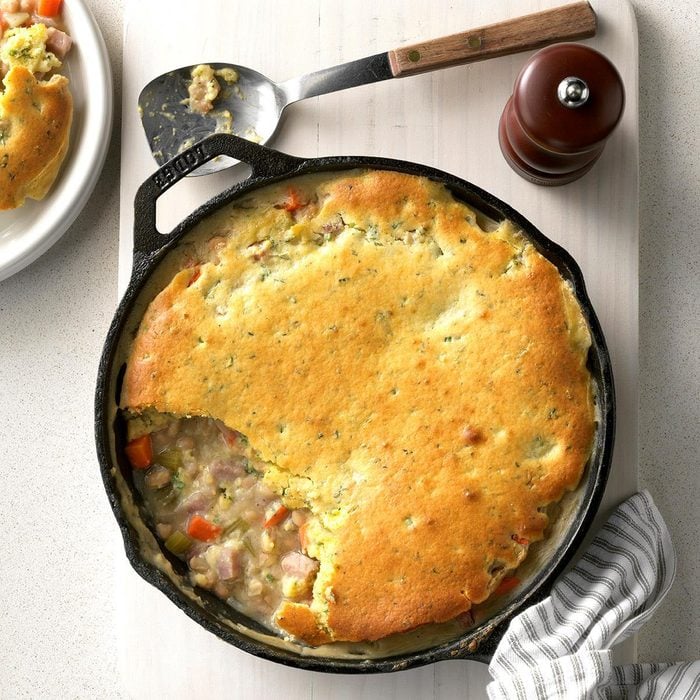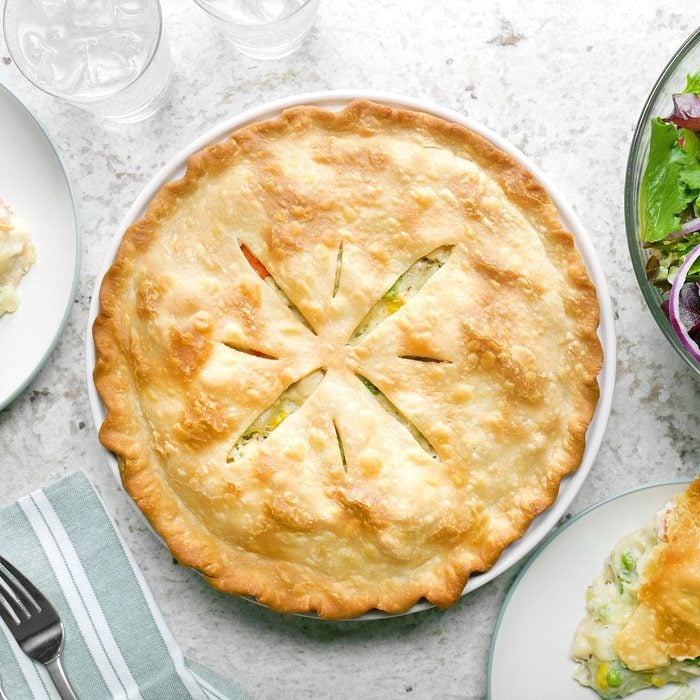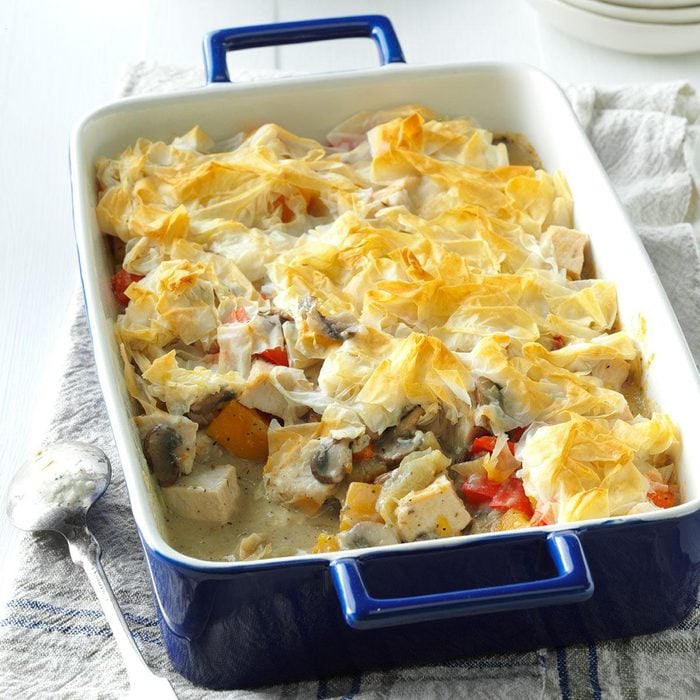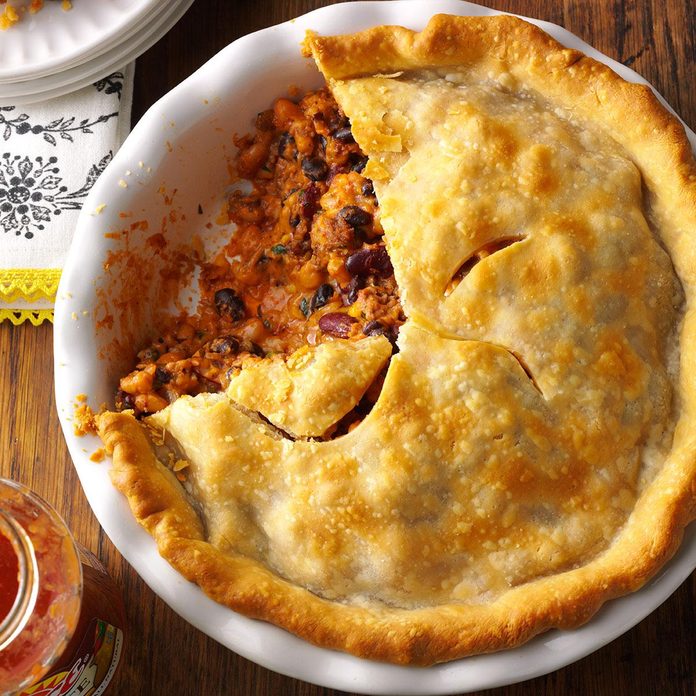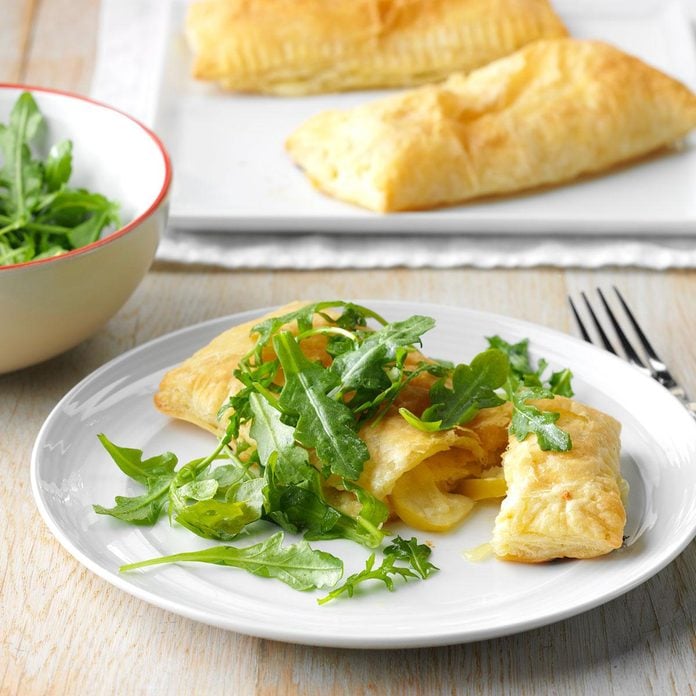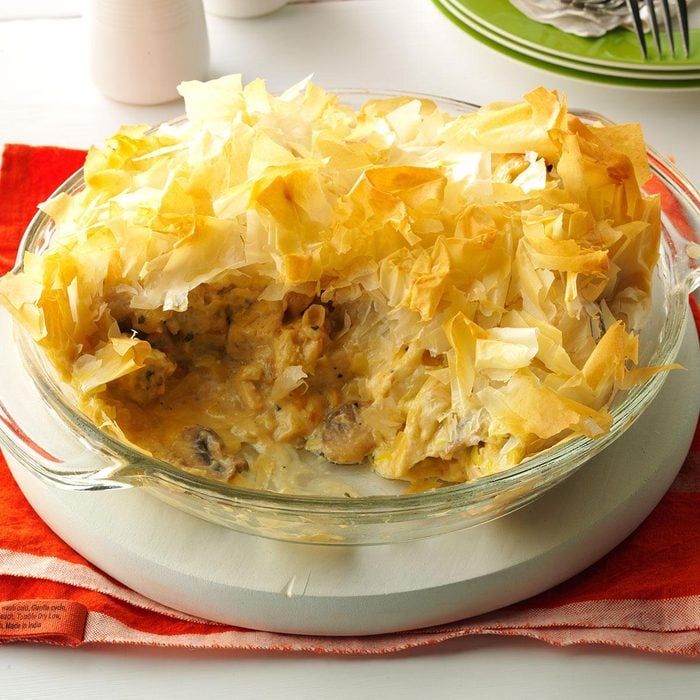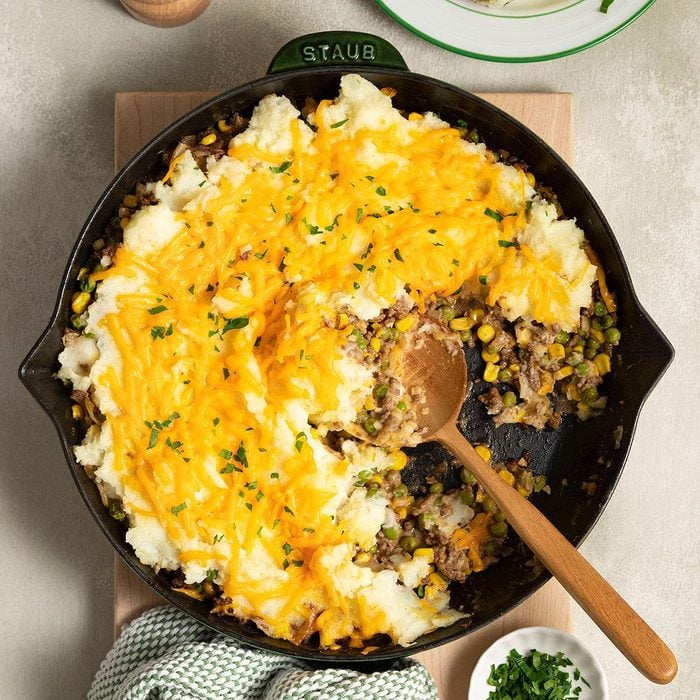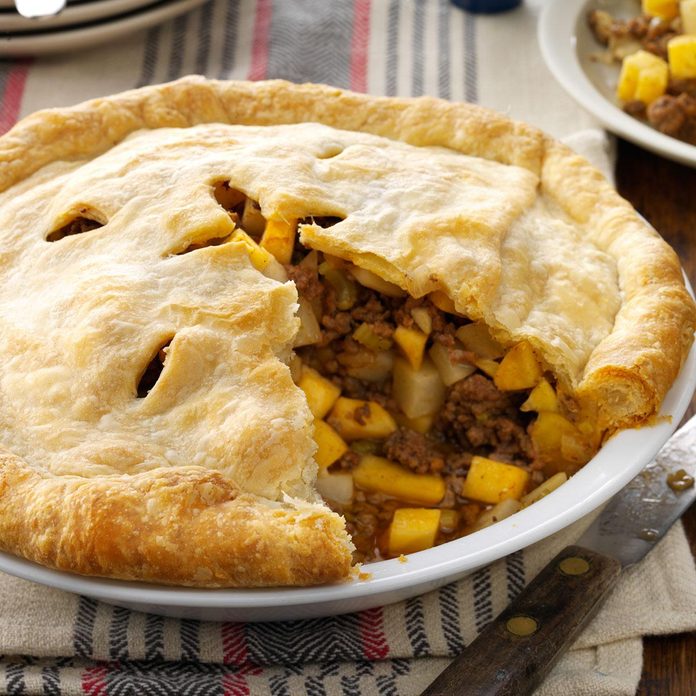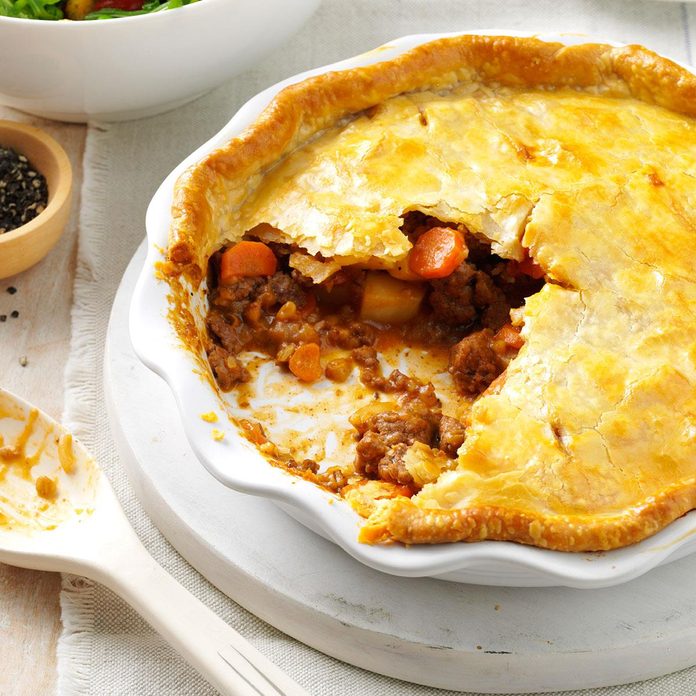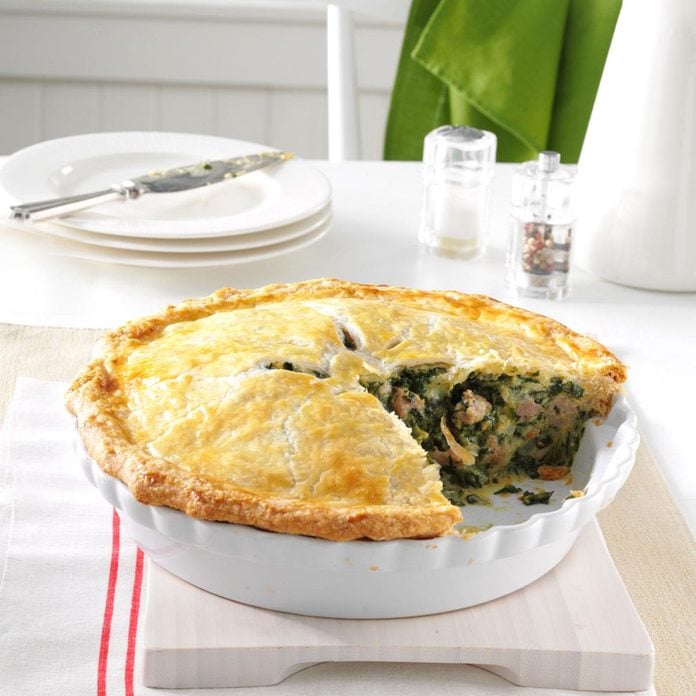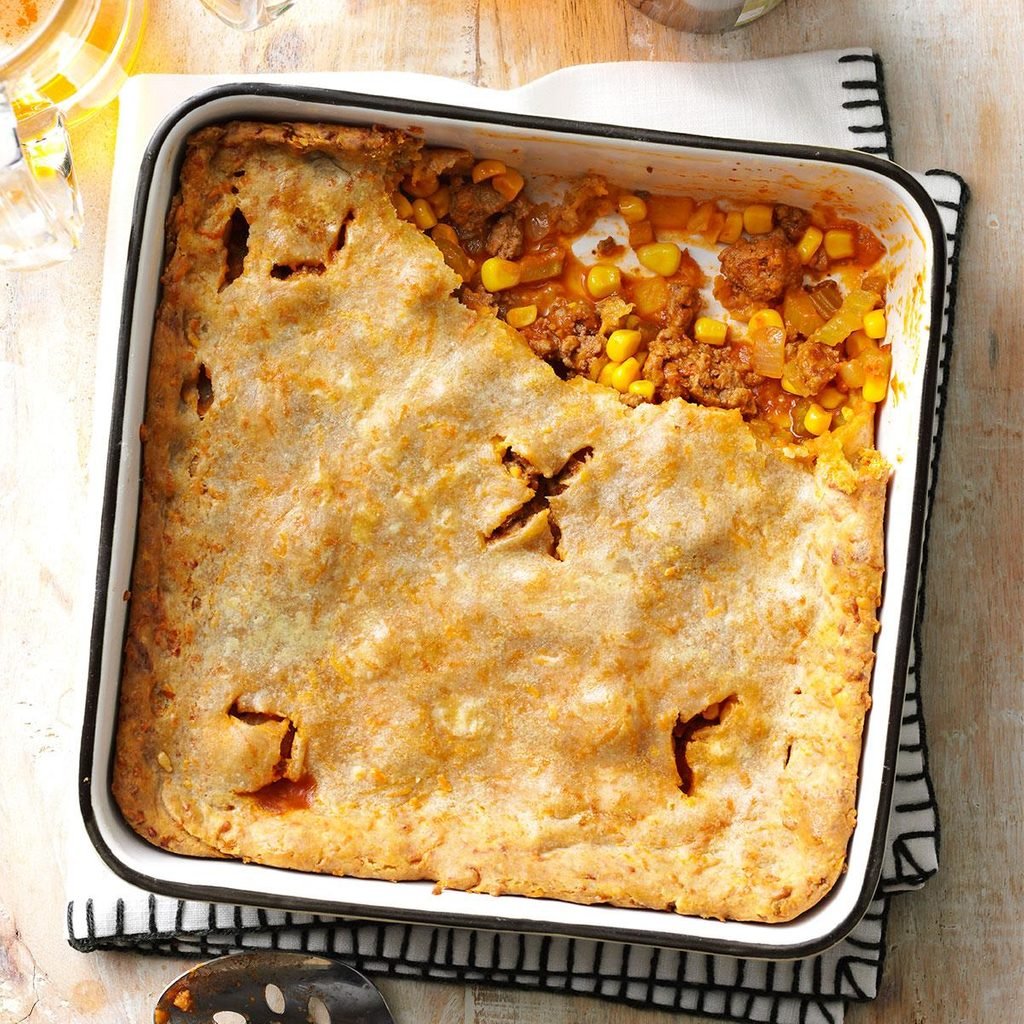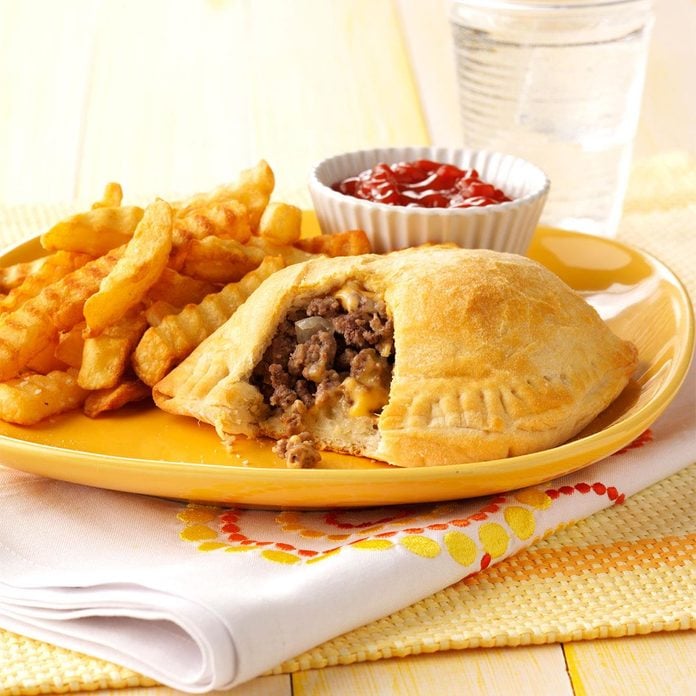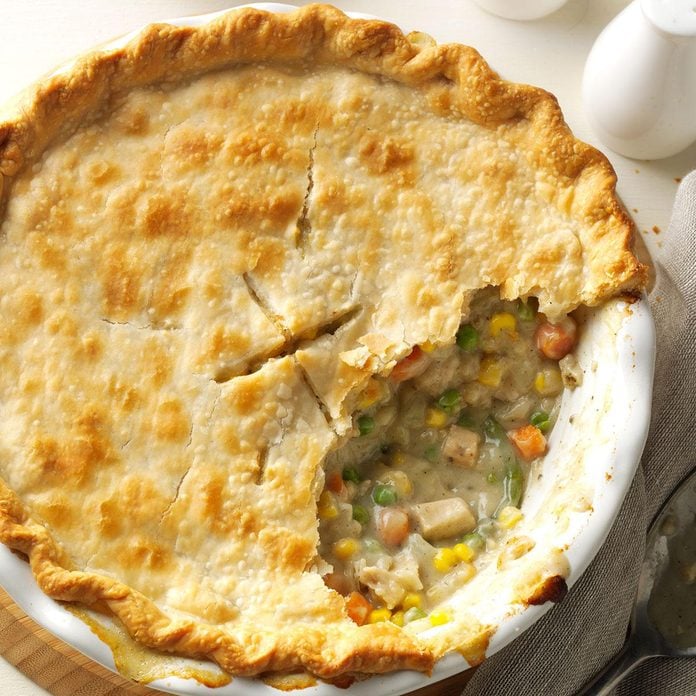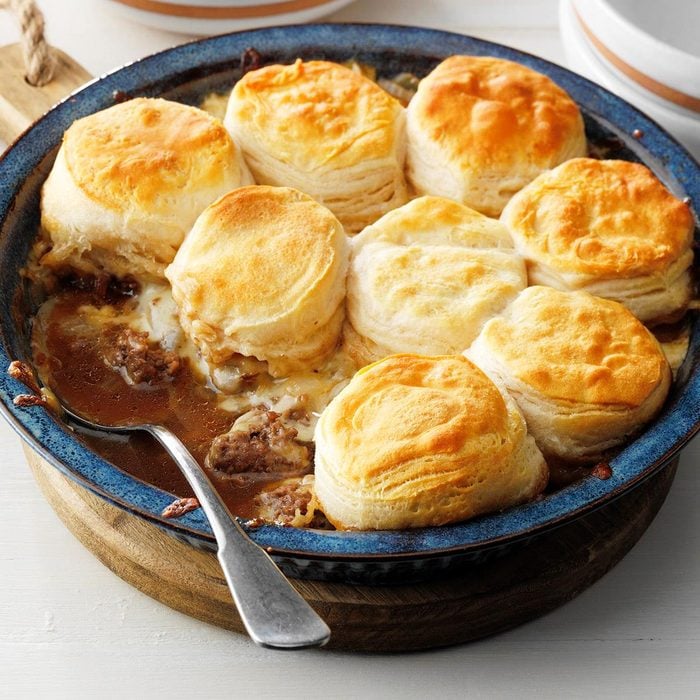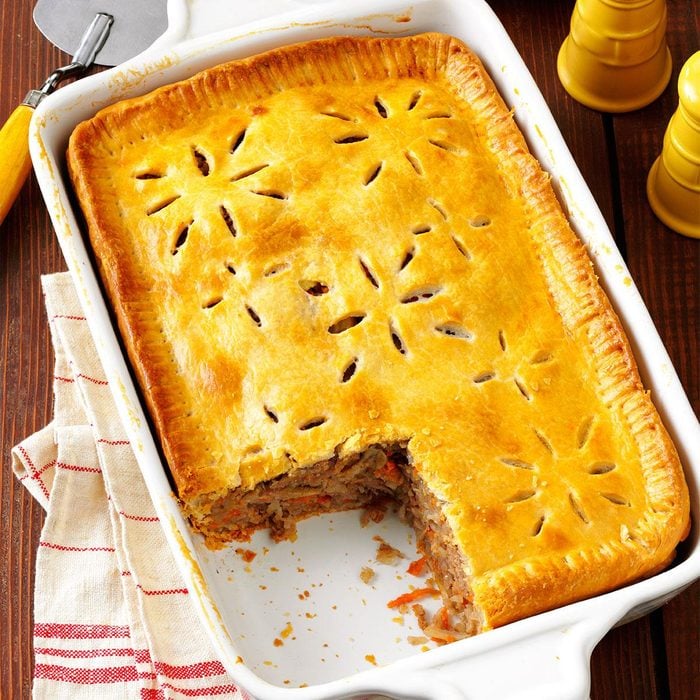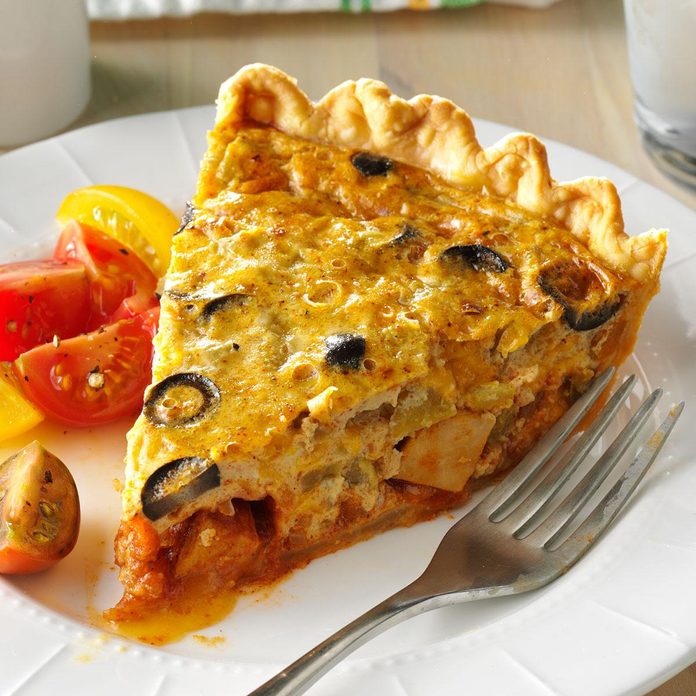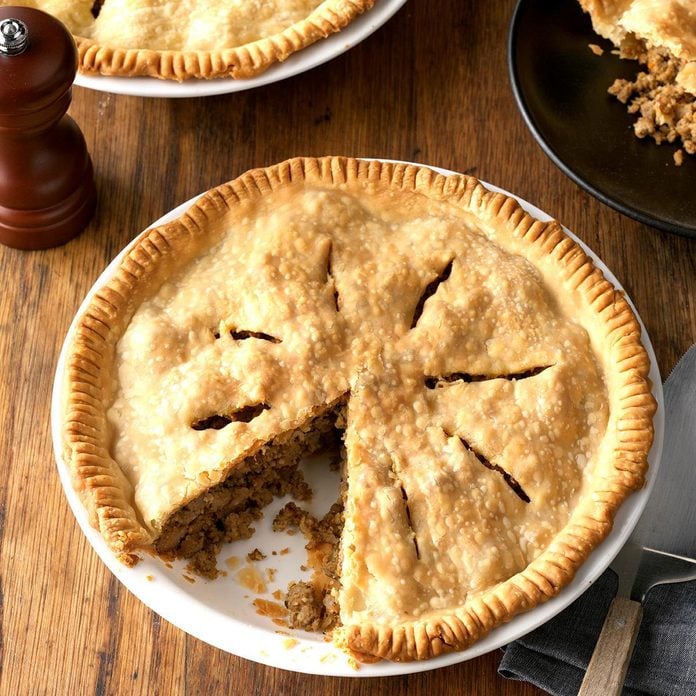Chicken Potpie Galette with Cheddar-Thyme Crust
This gorgeous galette takes traditional chicken potpie and gives it a fun open-faced spin. The rich filling and flaky cheddar-flecked crust make it taste so homey. —Elisabeth Larsen, Pleasant Grove, Utah
Get Recipe
Farmhouse Pork and Apple PieI've always loved pork and apples together, and this recipe combines them nicely to create a comforting main dish. It calls for a bit of preparation, but my family and I agree the wonderful flavor is well worth the effort. —Suzanne Strocsher, Bothell, Washington
Mini Shepherd's PiesI’m as confident serving these little pies to company as to family. If I have enough time, I’ll use homemade biscuits and mashed potatoes. —Ellen Osborne, Clarksville, Tennessee
Beef Stew Skillet PiePuff pastry makes a pretty topping for this homey skillet potpie. —Josh Rink, Milwaukee, Wisconsin
Mushroom and Sweet Potato PotpieThe last time I was in the U.S., I had an amazing mushroom and beer potpie at a small brewpub. It was so rich and comforting. I tried numerous versions when I got home and I think I've come pretty close! —Iben Ravn, Copenhagen, Denmark
Upper Peninsula PastiesI grew up in Michigan's Upper Peninsula, where pasties—traditional meat pies often eaten by hand—are extremely popular. There's a debate on whether they should be served with gravy or ketchup, but no matter what you dunk them in, they're super comforting. —Carole Lynn Derifield, Valdez, Alaska
Roadside Diner Cheeseburger QuicheMy savory main-dish quiche tastes just like its burger counterpart. Easy and appealing, this cheeseburger quiche is pretty enough to serve guests. —Barbara J. Miller, Oakdale, Minnesota
Cheddar Chicken PotpieCheese soup is one of my favorites, but it’s a bit too rich for my husband’s taste. Now I make a variation of potpie we both enjoy. If I’m in a hurry, I’ll skip the crust, add extra milk and serve it as a chowder. —Sandra Cothran, Ridgeland, South Carolina
Mini Sausage PiesThe simple ingredients and family-friendly flavor of these little sausage cups make them a go-to dinner favorite. And everyone gets their own pies—which makes them even better! —Kerry Dingwall, Ponte Vedra, Florida
Sloppy Joe PieTo be honest, I don't hear many compliments on this dish...folks are always too busy eating! I developed the recipe by grabbing ingredients from my refrigerator and cupboards one "crunch time" when I needed an easy dish
fast. —Kathy McCreary, Goddard, Kansas
Curried Chicken TurnoversWhenever I have leftover chicken, these turnovers are on the menu. The tasty secret is in the curry. —Laverne Kohut, Manning, Alberta
Senate Bean PotpieThe flavors from classic Senate bean soup inspired this hearty potpie with a cornbread topping. —Janice Elder, Charlotte, North Carolina
Best Chicken PotpieThis is the best chicken potpie recipe! Chock-full of chicken, potatoes, peas and corn, this recipe makes two golden pies, so you can serve one at supper and save the other for a busy night. —Karen Johnson, Bakersfield, California
Company Turkey PotpieHere's our smart spin on potpie, filled with turkey, autumn vegetables and a creamy herb sauce. Best of all, there's no crust to make—just top with prepared phyllo dough. —Taste of Home Test Kitchen
Mini Pork PiesAs a child, I discovered my love of pork pies. I used to help my father deliver oil on Saturdays, and we would stop at a local place to have the meaty pastries for lunch. —Renee Murby, Johnston, Rhode Island
Spicy Bean and Beef PieMy daughter helped me come up with this recipe when we wanted a one-dish meal that was different than a casserole. This pie slices nicely and is a fun and filling dish. —Debra Dohy, Massillon, Ohio
Nacho PieIn place of the ground beef and mozzarella cheese, consider topping this zesty pie with lean ground sausage and cheddar cheese. It tastes just as good.—LaVerna Mjones, Moorhead, Minnesota
Chickpea PotpiesMy family loves potpies, and with this recipe, no one—not even my carnivores—misses the meat. Hungry teens and adults gobble them up! —Annette Woofenden, Middleboro, Massachusetts
Easy Chicken Tamale PieAll you need are some simple ingredients from the pantry to put this slow-cooker meal together. I love the fact that I can go fishing while it cooks. —Peter Halferty, Corpus Christi, Texas
Apple, White Cheddar & Arugula TartsThese tarts remind me of the autumns I spent in Michigan, where I grew up. —Maria Davis, Hermosa Beach, California
Cheesy Chicken and Leek Phyllo PieIn our house, chicken potpie is a year-round staple. For a springtime feel, we use leeks and mushrooms and a lighter phyllo dough crust. If you don't have gruyere, try Parmesan. —Andrea Stewart, Toronto, Ontario
Mediterranean Turkey PotpiesYour clan will love these wonderful stick-to-the-ribs potpies with a Mediterranean twist. I always use the leftovers from our big holiday turkey to prepare this recipe. I think my family enjoys the potpies more than the original feast! —Marie Rizzio, Interlochen, Michigan
Skillet Shepherd's PieThis is the best shepherd's pie recipe I've ever tasted. It's very quick to make, and I usually have most—if not all—of the ingredients already on hand. —Tirzah Sandt, San Diego, California
Miniature Meat PiesI make these handheld pies in advance, keep them in the freezer, then bake them the day of the party. They are always a hit at tailgate and potlucks. —Gayle Lewis, Yucaipa, California
Rutabaga PieThis is a variation of a recipe my mom used to make. I changed a few things so it's easier to prepare. My whole family enjoys this hearty main dish. —Patricia Kron, Oak Creek, Wisconsin
Easy Beef PiesWe make a lot of French dips and always have leftover roast beef. Here's how I put it to good use. For these pies, use any vegetables you like. They're extra awesome drenched in cheese sauce. —Jennie Weber, Palmer, Alaska
Chicken & Cheese Tortilla PieTrust me when I say this hearty dish can be assembled in minutes, then devoured even quicker with no leftovers. —Karen Kuebler, Dallas, Texas
Savory Turkey PotpiesThis will perk you up on a cold, rainy day. You can use chicken in place of turkey, and I like to serve the potpies with a fresh green salad or cranberry sauce on the side. —Judy Wilson, Sun City West, Arizona
Skillet BBQ Beef PotpieBeef potpie is a classic comfort food, but who's got time to see it through? My crowd-pleaser is not only speedy but an excellent way to use leftover stuffing. —Priscilla Yee, Concord, California
Mushroom & Leek PieIn the Pacific Northwest, we make a savory pie with mushrooms and leeks. We prefer chanterelle, but baby portobello or oyster mushrooms will also delight your diners. —Vickie Woods, Salem, Oregon
Black Bean Tamale PieCornbread mix speeds the preparation of this southwestern entree with beef and black beans. My husband really likes it, and guests seem to enjoy this unique Mexican dish. For a change of pace, try topping it with lettuce, guacamole or extra salsa. —Laura Morris, St. Joseph, Missouri
Tasty Meat PieI work full time as a nurse, so I depend on quick and easy meals like this one. My sister suggested I use canned soups instead of prepared gravy. Now my husband and teenage son ask for seconds and even thirds. —Cheryl Cattane, Lapeer, Michigan
Pork Shepherd's PieOf all the shepherd's pie recipes I've tried through the years, this version is my favorite. Although I live alone, I enjoy cooking and baking for friends and family. —Mary Arthurs, Etobicoke, Ontario
Italian Sausage and Spinach PieThe basic recipe came from my mother, but I've added a few ingredients. The flavors blend so well, and it even tastes good cold. This makes a hearty supper, especially when you serve it with a side of pasta. —Teresa Johnson, Peru, Illinois
Beef Pot PieFor more than a dozen years, this has been the No. 1 dish to serve company at our house. So far, everyone has given it a thumbs-up rating. —Hannah McDowell, Penns Creek, Pennsylvania
Turkey Lattice PieWith its pretty lattice crust, this cheesy baked dish looks as good as it tastes. It's easy to make, too, since it uses ready-to-go crescent roll dough. —Lorraine Naig, Emmetsburg, Iowa
Cheeseburger PocketsGround beef is my favorite meat to cook with because it's so versatile, flavorful and economical. Refrigerated biscuits save you the trouble of making dough from scratch. —Pat Chambless, Crowder, Oklahoma
Spinach Beef PieI found this recipe about 15 years ago, and it's still one I turn to often. It's flavorful and pretty.—Meg Stankiewicz, Garfield Heights, Ohio
Easy Cheddar Chicken PotpieMy kids love chicken potpie, and I really like that this is so quick and easy to put together with frozen veggies and store-bought gravy. To make it even simpler, my friend and I decided to top it with a biscuit crust instead of homemade pastry. It’s delicious! —Linda Drees, Palestine, Texas
Provolone Beef Pastry PocketsMy children always make sure they're home when they find out we're having these pockets for dinner. They're a smart way to use leftover pot roast. —Karen Burkett, Reseda, California
Black Bean Tortilla PieI found this entree a while ago and decreased the cheese and increased the herbs called for in the recipe. It’s one of my toddler’s favorite meals. She always smiles when she sees it on the table. —Wendy Kelly, Petersburg, New York
Homemade Chicken PotpieWhy look for potpie in the frozen food aisle when this easy version tastes much better? The chicken pot pie's crust is so tender and flaky, and underneath you'll find the ultimate comfort food for kids and adults. —Amy Briggs, Gove, Kansas
Beefy French Onion PotpieI came up with this dish knowing my husband loves French onion soup. It makes a perfect base for the hearty, beefy potpie. —Sara Hutchens, Du Quoin, Illinois
Pinwheel Steak PotpieOn cool nights, nothing hits the spot like a steaming homemade potpie—especially one you can get on the table fast. The pinwheel crust on top has become my signature. —Kristin Shaw, Castleton, New York
Finnish Meat PieWe enjoy this hearty, traditional meat pie year-round, but especially during hunting season. This is one recipe I'll be sure to pass on to our seven children.— Laurel Skoog, Frazee, Minnesota
Chicken Taco QuicheI wanted to make a quiche but didn't want the usual flavors, so I used ingredients I had in my pantry and refrigerator to come up with this recipe. I was surprised at the great taste and how well the flavors came together. My neighbor asked for the recipe and had the same success! —Tamie Bradford, Grand Forks AFB, North Dakota
Western Beef and Cornmeal PieWith this hearty main dish recipe, the bread is baked right in the casserole. The meal covers all four food groups, and it's a guaranteed family pleaser. —Darlene Alexander, Nekoosa, Wisconsin
French Canadian TourtieresThis recipe comes from my big sister. Each fall, we get together and make about 20 of these pies to use at Christmas, give as gifts or freeze for unexpected company. —Pat Menee, Carberry, Manitoba
